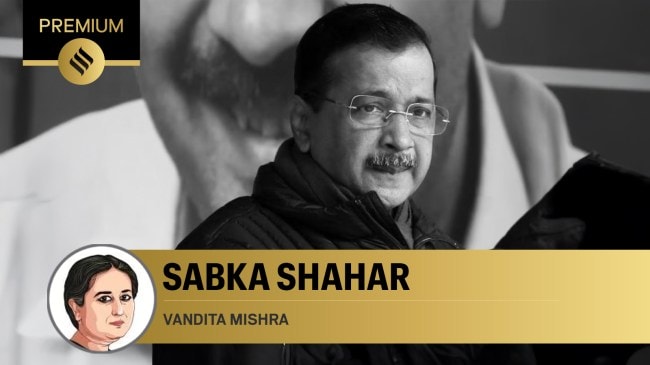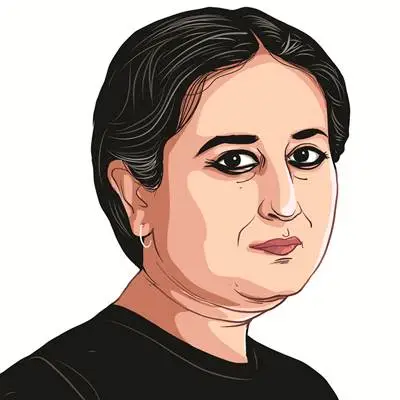Opinion Vandita Mishra writes: AAP has given BJP building blocks of what could become a new layer in the political vocabulary
It will now be the BJP’s challenge to tailor its politics to the city.
 When the AAP burst onto the political scene in 2012, fought its first election in 2013, almost in tandem with the rise of the Modi-BJP at the Centre, it was a party born of a national “anti-corruption” movement (Express Photo/Amit Mehra)
When the AAP burst onto the political scene in 2012, fought its first election in 2013, almost in tandem with the rise of the Modi-BJP at the Centre, it was a party born of a national “anti-corruption” movement (Express Photo/Amit Mehra) The Narendra Modi-led BJP and the Arvind Kejriwal-led AAP — Delhi’s victor and vanquished — rose to national prominence at about the same time. The Delhi 2025 verdict represents a new turn in the story of two parties, and two politics.
After 2014, the Modi-BJP rearranged the political vocabulary by, broadly, dividing the political party’s appeal to voters into two categories: One, the public provisioning of private goods alongside cash transfers and subsidies that reach into households to touch individual labharthis (beneficiaries). Two, the projection of larger wholes that offer belongingness, be it desh (nation) and desh-in-videsh (India in the world), or Hindu samaj (religious identity). And a kind of religious nationalism that combines the two narratives and sets up an Other or Others (Muslim and left-liberal/ “urban Naxal”) to define itself in opposition to.
The space that stretches between the beneficiary household and the larger imagined community could be occupied, in no particular order, by issues of mehengai or price rise, corruption, farmers’ concerns, unemployment or berozgari.
It is not that this didn’t happen earlier. But there was a difference after the BJP reset the political field. Earlier, too, parties targeted individual voters through actual and proposed schemes but the BJP’s remaking of the citizen into the “labharthi” carried the ring of a ceremonial renaming with political consequences. Similarly, parties had invoked larger wholes in the past — of class, caste, regional identity — but the BJP’s religious nationalism succeeded in making them look smaller and paler. It did so by tapping into dormant or long-simmering emotions and impulses that had not been fully confronted or addressed by mainstream politics.
When the AAP burst onto the political scene in 2012, fought its first election in 2013, almost in tandem with the rise of the Modi-BJP at the Centre, it was a party born of a national “anti-corruption” movement. But it was also a party of, by and for the city — the Anna Hazare movement had become a critical selfie moment for Delhi.
The AAP, too, tweaked the political imagination and script. It gave the issue of corruption, always-already present in public conversation, a new currency. It opposed the BJP while playing the Hindutva card on terms set by the BJP. But more importantly, between the desh and individual labharthi, it brought in the mindscape of the city.
Of course, this was not always an act of intentional politics. Far too often, in fact, it seemed that the AAP saw in Delhi only a stepping stone to its national-level ambitions. But because of the circumstances of its birth, and almost despite its own blind spots and overreach, Kejriwal’s party introduced a missing middle tier in politics.
Again, it wasn’t as if the city wasn’t a part of the political imagination earlier. But it was only waveringly so. The city has generally got short shrift in national and especially north Indian politics dominated by the larger numbers of rural voters and what has been generally seen as their more fundamental needs. Urban issues have long been eclipsed, or lobbed into the court of patchily empowered local urban bodies.
The new party born in Delhi talked of the city, and in it, focused on the government school and mohalla clinic. In a burgeoning city of migrants, to ease arduous struggles for acquiring a foothold, it gave electricity and water subsidies — this was a class of voters whose concerns were so far marginalised in the prevalent ways of seeing urban spaces as populated only by middle and upper classes. In a city on the move, it provided women bus rides for free.
The AAP made the city — and parts of it that live most precariously — visible in the political discourse. And because the city was Delhi, less the place you were born in, and more the place to which you were going, the task of politics was not just to help fashion a home for the citizen, but also a safe house for her aspirations and dreams.
The AAP’s challenge, therefore, lay in addressing the real city, with its bijli, sadak, paani, kachra-sewage and padhai problems. And to create the infrastructure for freedom and anonymity and upward mobility in the imagined city. Over two terms, it managed more or less, and less and less increasingly.
In the last two elections, the people voted the AAP for Delhi, even as at the Centre they supported the BJP. Eleven years later, as the Delhi scoreboard shows, a large enough section of the people feels that the AAP let them down in its custodianship of the city. At the same time, however, the 2025 election campaign affirmed that the middle tier in the political imagination, the space the AAP was a creation of and which it helped shape, is here to stay.
It was audible in the insistent voter refrain about the need for more hospitable and efficient, less dishevelled and cramping, public spaces — voters spoke of the necessity of smoother roads, better sewage systems, cleaner air and neighbourhoods. It was heard in the what-next queries about the mohalla clinic and renovated government school. It was there in the exasperated if rhetorical question asked by young and old in the unauthorised colony and middle class enclave: Didn’t Kejriwal promise to make Delhi like London and Paris?
These concerns made themselves heard over and above the signs of boredom and desire for change, the markers of growing Hindu consolidation, and agitation over what some call subsidies and others label as “freebies”.
It will now be the BJP’s challenge to tailor its politics to the city. The easy bit will be the cash transfer and subsidy — the Modi-BJP has rehearsed that part nationally and in other states, for instance with the Ladki Bahin Yojana that was declared the match-winner in Maharashtra most recently.
But going ahead, it will need to remember that the city is more than the sum of its individual parts — and in comparison to the nation, more urgent and concrete. The city requires, to begin with and most of all, a respect for a publicness that is inclusive and encompassing. Where caste and religion may matter but are also made less bounded — by the need to move ahead, the imperative not to stand still.
The AAP failed to live up to its opportunity. The BJP would do well to recognise that the AAP has given its successor not just Delhi’s hot seat but also the building blocks of what could become — if it is open to the possibility — a new layer in its political vocabulary.





